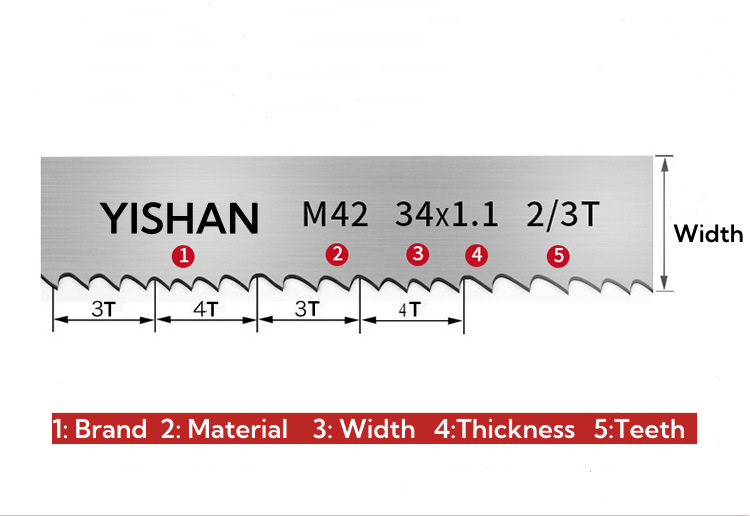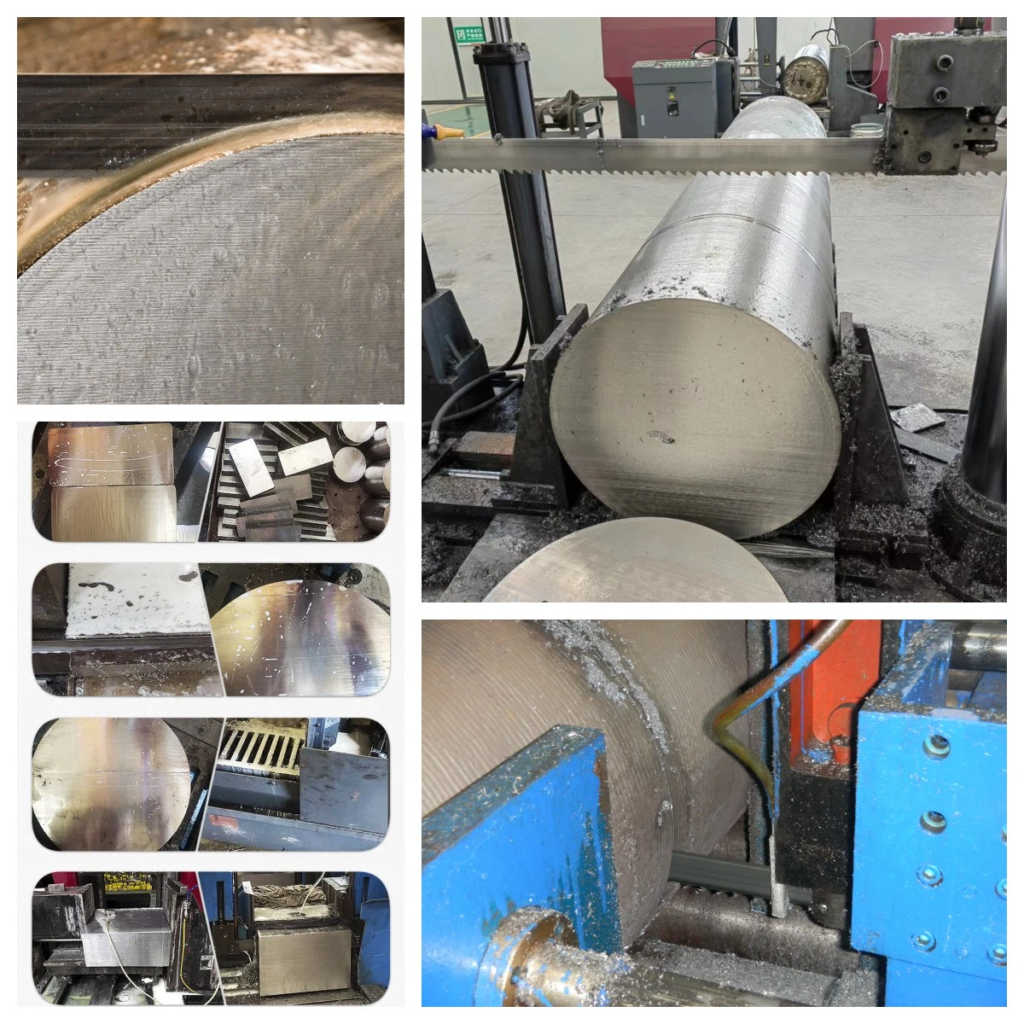Band saw blades are crucial for high-precision cutting in metal, wood, and even food processing industries. However, one factor that often stumps buyers is TPI, which is tooth per inch. Get it wrong, and your cutting efficiency plummets, wasting time and money.
TPI (teeth per inch) is critical in determining a band saw blade’s effectiveness for cutting specific materials. The proper TPI balances cutting speed with smoothness, impacting not only the quality of cuts but also the lifespan of the blade.
Knowing which TPI suits each material type optimizes costs and ensures precision. Read on to discover the right TPI for your needs, from coarse cutting to fine finishing.
What is TPI?
In simple terms, TPI stands for Teeth Per Inch, which tells you how many teeth are on a one-inch section of the blade. Each material has specific TPI needs:
- Low TPI (2-6 TPI): Used for fast, aggressive cuts in thick, hard materials like bones and rough wood.
- Medium TPI (8-12 TPI): A versatile range suitable for both metal and denser wood. These blades offer a balance between speed and smoothness.
- High TPI (14-24 TPI): Ideal for precise cuts in thin materials, soft metals, or intricate woodwork, where finish quality is essential.
Let’s look at each application in detail to see how TPI can impact our cutting efficiency and quality.
Why is TPI Important?
TPI is crucial for several reasons:
- Cut Quality: The TPI affects the cut’s finish. Higher TPI blades tend to produce smoother cuts, while lower TPI blades may leave rough edges. This is less crucial in meat processing, but smoothness is often important for woodworking and metal cutting.
- Material Compatibility: Different materials require specific TPIs for efficiency. For example, cutting dense bones or thick wood is most effective with low TPI blades. In contrast, cutting metals or delicate wood may need higher TPI to avoid material chipping or snagging.
- Processing Speed: Lower TPI blades cut faster but may sacrifice smoothness, which can be ideal for initial cuts in wood or bone. Higher TPI blades slow down the cutting process but enhance accuracy, making them suitable for intricate cuts in wood or precise metal work.
Understanding these factors will help us choose the right TPI for each type of material, maximizing quality and productivity.
Selecting the Right TPI Based on Material Type
TPI for Meat and Bone Processing
- 3 TPI: Best for dense bones, these blades allow fast cuts without jamming, perfect for breaking down large pieces of meat with bones, such as pork or beef. reduces clogging and helps the blade withstand hard materials without wearing out quickly.
- 4 TPI: works well for softer bones or boneless meat cuts, where precision and edge quality are more crucial. This TPI range is useful for applications that combine speed with a cleaner finish.
Choosing the right TPI in meat processing allows smoother operations and reduces the need for frequent blade changes, saving time and costs.
TPI for Metal
Metal cutting requires precise TPI selection to balance cut speed and finish quality. Here’s a breakdown:
- 1-4 TPI: Suitable for cutting thicker metals or tubes. This TPI balances speed and cut quality, allowing for smooth, efficient cuts without excessive wear on the blade.
- 6-10 TPI: Effective for mid-range metal thicknesses, such as mild steel or aluminum. This range enhances control and reduces the likelihood of rough edges or burrs.
- 10-14 TPI: Ideal for cutting thin metal sheets or tubes, especially stainless steel and other delicate metals. Higher TPI ensures a clean, smooth finish, which is essential for precision metalwork where edge quality is crucial.
Choosing the right TPI minimizes material waste, improves cut accuracy, and ensures that the blade can handle different metal densities without dulling too quickly.
TPI for Wood Cutting
Wood processing also requires thoughtful TPI selection to achieve efficient cuts. Depending on the type and thickness of the wood, the TPI needed may vary:
- 2-4 TPI: Ideal for ripping through thick, rough wood, such as lumber or large tree branches. These blades move fast, removing large amounts of material with each pass, though they may leave rough edges.
- 6-10 TPI: A versatile choice for general woodworking, including hardwoods like oak or maple. This TPI range balances speed and finish quality, making it effective for both straight cuts and shaping work.
- 14-18 TPI: Suitable for delicate or intricate woodworking, such as cutting veneers or softwoods like pine. This higher TPI allows for smooth finishes and controlled cuts, which are perfect for detailed work.
Selecting the right TPI for wood cutting enhances both productivity and precision, ensuring that each cut is smooth and meets quality expectations without needing further refinement.
Effects of TPI on Cutting Performance
TPI directly affects a blade’s cutting performance across all materials:
- Lower TPI blades (2-4) are aggressive, removing material quickly and creating rougher edges, ideal for dense bones or thick wood. However, they may lack precision for delicate cuts in meat or thin metals.
- Medium TPI blades (6-10) balance speed and finish quality, suitable for softer bones, mid-thickness metals, and general woodworking.
- Higher TPI blades (10-14) cut more slowly but offer precision and smoothness, ideal for thin metals and intricate woodwork.
Knowing how TPI affects performance can help you optimize your material handling, reduce waste, and maintain high-quality standards across diverse applications.
Tips for Purchasing Band Saw Blades with the Right TPI
When sourcing band saw blades for diverse materials, keep these points in mind:
- Understand Material Needs: Different materials require different TPI levels, so knowing what you’ll cut most frequently is essential for choosing the right blade.
- Verify Supplier Quality: Not all suppliers offer blades that meet food, metal, or woodworking safety and performance standards. Ensure your supplier has a strong reputation for quality.
- Bulk Orders for Cost Efficiency: Purchasing in bulk can reduce costs, especially if you process a high volume of similar materials. Keeping a range of TPI blades in stock gives you flexibility in production.
- Customization: If you require specific features, such as branding or blade coating, confirm the supplier can accommodate this without excessive costs.
- Payment and Delivery Options: Check if suppliers can meet your preferred payment and delivery requirements, especially if ordering internationally. Reliable payment terms can simplify transactions and maintain consistent supply.
By following these tips, you can secure the right blades for your needs, streamline operations, and meet quality standards across meat, bone, metal, and wood processing.
Summary
TPI is crucial when selecting band saw blades, especially when processing various materials, from meat and bone to metal and wood. By understanding TPI’s impact on cut quality, speed, and material compatibility, you can choose the best blade for each application. Remember, assessing your material needs and verifying supplier quality can help you make the most cost-effective and efficient choices.
Selecting the right TPI blade for your processing needs enhances productivity and ensures quality results, helping you meet both production demands and customer expectations. If you have questions about TPI or need further assistance, please reach out!




